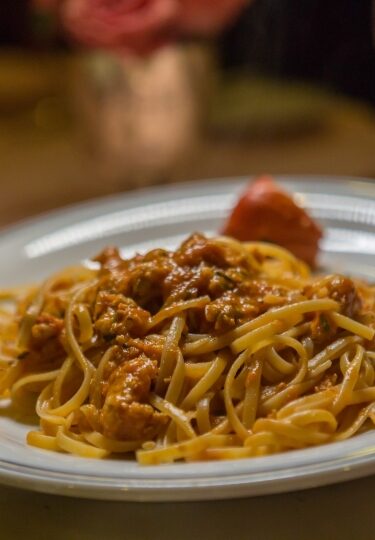The food in Venice is as culturally nourishing and downright delicious as the Venetian-gothic facade of the Doge’s Palace. Fortunately, it’s also much more digestible.
With water such an intrinsic part of Venetian existence, seafood is strongly represented in the gold-embossed, hard-backed menus of the city’s trattorias. With its long history as a trading port in the Adriatic, Venetian food also bears some hallmarks of Scandinavian as well as Eastern influence.
In addition to seafood, you’ll find delicious meaty morsels and more than a few sweet treats, often laced with booze. Read on for a list of the must-try food in Venice.
Sarde in Saor
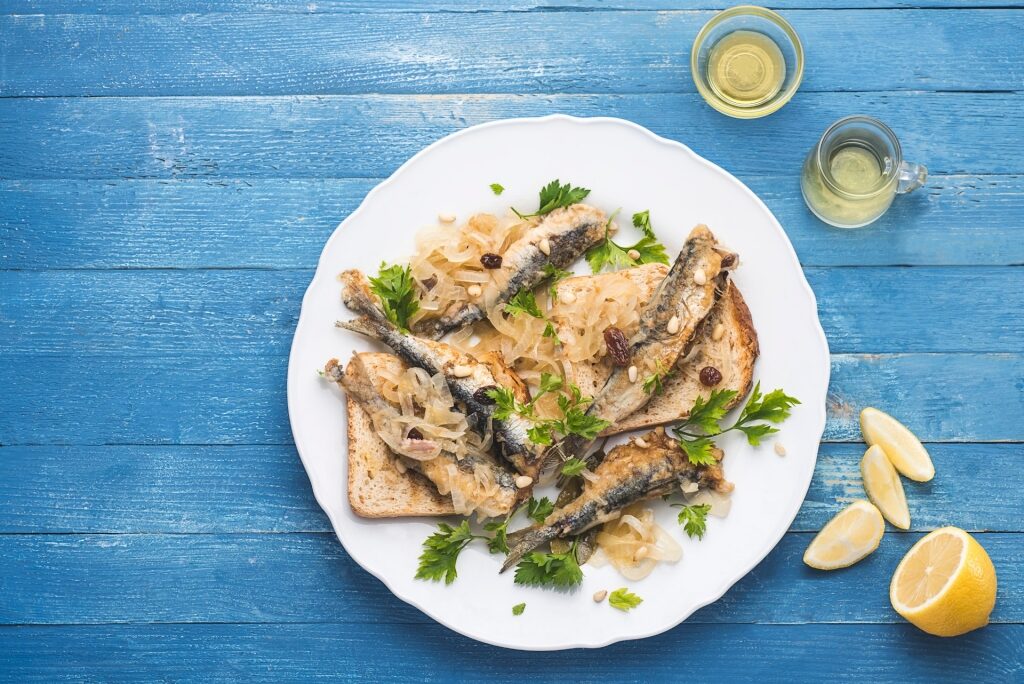
Sarde in saor
A favorite fishy beginning to any Venetian feast, sarde in saor is a small plateful of marinated sardines. Saor translates as “flavor”. The tradition of preserving sardines is handed down from the medieval era when Venetian sailors required snacks on long journeys. Preserving fried food in Venice is also a typical practice.
In sarde in saor, the fish are fried to a golden finish before being plunged into a sweet and sour mix of white wine, vinegar, pine nuts, onions, and raisins. Marinades will vary, but the result is always tangy, light, and delicious.
While you can find these on menus year-round, your opportunity to gorge on sarde in saor is on July 15th, during the Festa del Redentore. Featuring an abundance of fireworks elegantly reflecting in the lagoon’s waters, the festival celebrates the end of a medieval plague that killed off thousands of Venetians, including the painter, Titian.
Fritto Misto
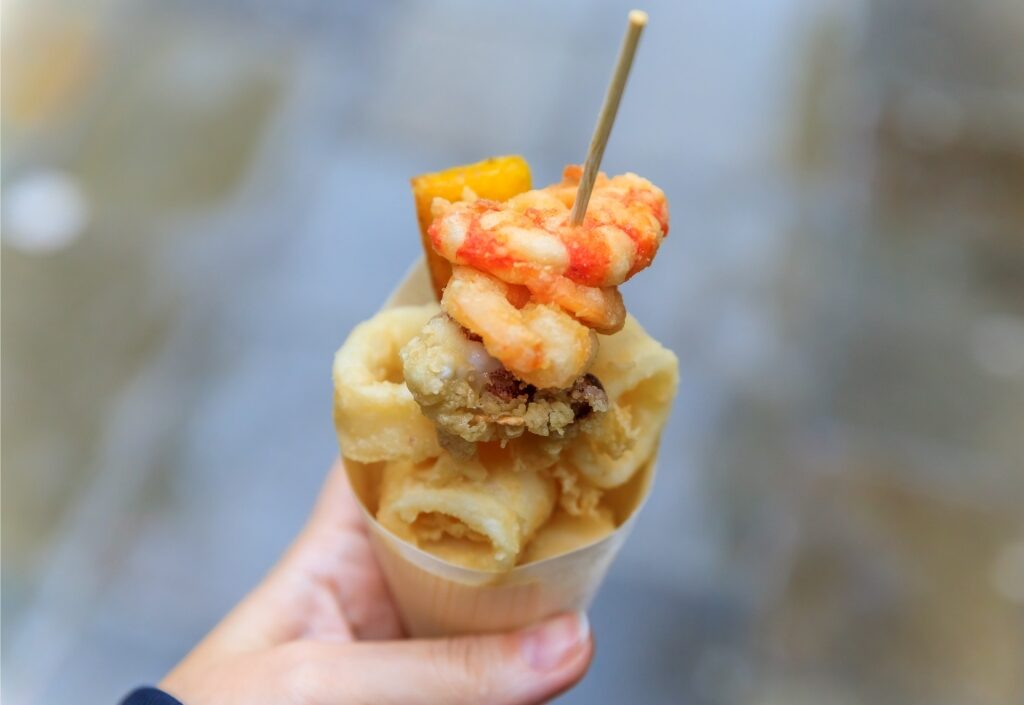
Fritto misto
While Fritto Misto’s origins are debated—some say Venice, others claim Genoa—it’s obvious that such a simple yet delicious preparation of seafood was always going to travel far.
It’s a blend of calamari, shrimp, and fish that is dusted with semolina before frying. A squeeze of lemon over the top, and you have a fresh, hot, crisp mouthful that’s endlessly more-ish.
While it’s most commonly eaten out of a paper cone, or cartoccio while relaxing on the beach, eating fritto misto always feels right while strolling or sitting close to a Venetian canal.
Risotto al Nero di Seppia
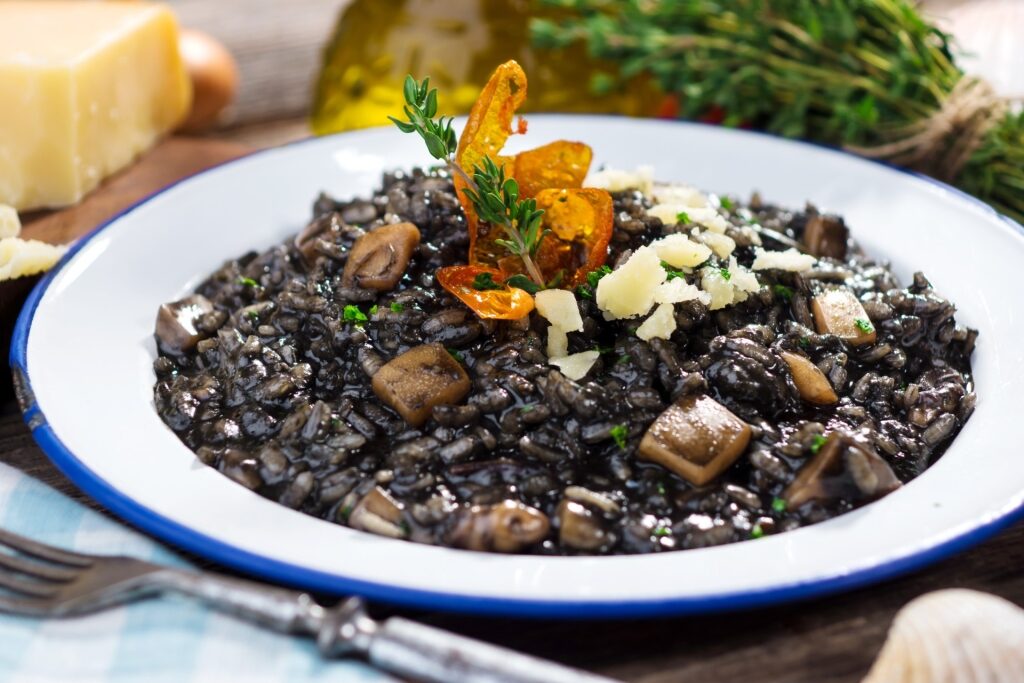
Risotto al nero di seppia
Combining the wealth of Vialone Nano rice grown in the Veneto region with the abundant squid in the Adriatic, risotto al nero di seppia is one of the signature dishes of the Venetian kitchen.
A bowlful as jet black as the Venetian Lagoon under a moonless sky, risotto al nero di seppia sees the rice grains dyed with squid ink. This culinary innovation can be found beyond the Venetian canals, but this recipe is one of the most famous employing the squid’s ink sacs.
You’ll find sweet, succulent pieces of squid braised in wine and tomatoes among the earthy grains. In contrast to typical risotto recipes, cheese is omitted so as to not overpower the dish’s more delicate flavors.
Venetian risotto is also served “all’onda”, which translates as “wave”, describing a more fluid, soupy bowlful than other risotto-favoring regions might produce.
Cicchetti
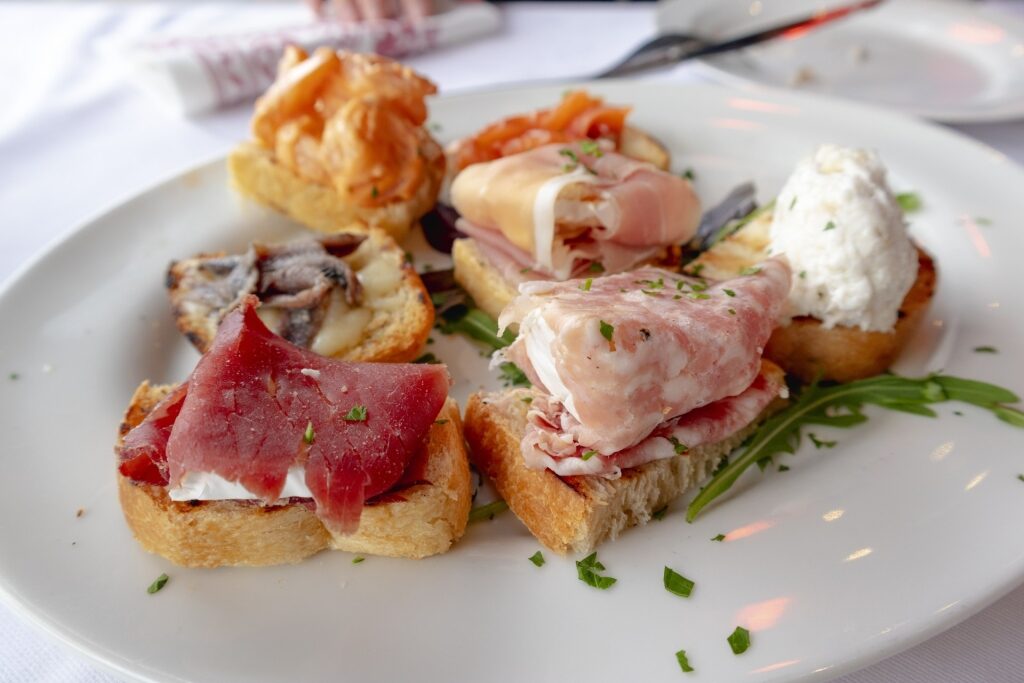
Cicchetti
While touring Venetian bars, or bacaro, you’ll spot locals enjoying platefuls of enticing, eclectic morsels often secured to bread slices by cocktail sticks. These are cicchetti.
The stars of Venice’s pre-dinner aperitivo period, cicchetti are anything from marinated sardines to a slice of fig pinned to a tissue of prosciutto on bread. They’re often considered a form of Italian tapas, it’s a regular practice in Venice for the locals to tour a few bacari, eventually putting together a multi-course meal entirely comprising cicchetti.
Venice is known for its unique flavor combinations, many of which can be found amid these small plates. Think eggplant wrapped around creamy robiola cheese, polpette of deep-fried sea bass in breadcrumbs, and the famous moscardini, or baby octopi.
Risi e bisi
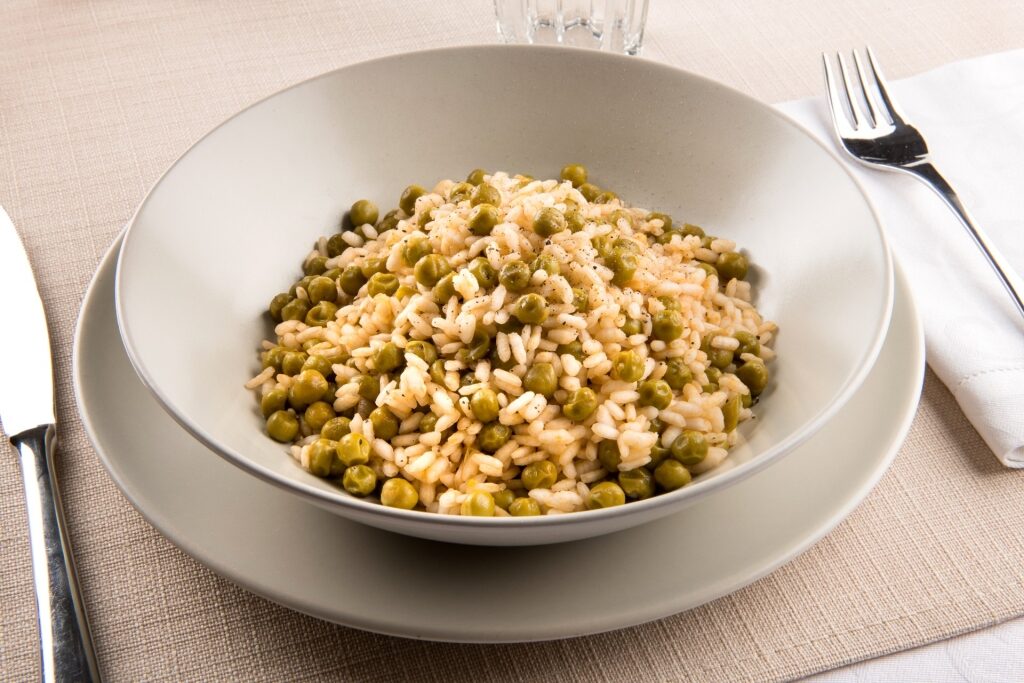
Risi e bisi
A springtime favorite in Venice, risi e bisi is a dish that slots somewhere between the risotto and a soup. It’s also the flagship dish of Venetian National Day, on the feast of St. Mark.
It’s best in the spring when made with the freshest, sweetest peas. The dish is cooked with white wine, although some luxurious recipes add prosecco instead. Cubes of salty pancetta are also added to the creamy Vialone Nano rice. Stracchino cheese is often folded in to finish this gloriously fresh and indulgent plateful.
Baccalà Mantecato
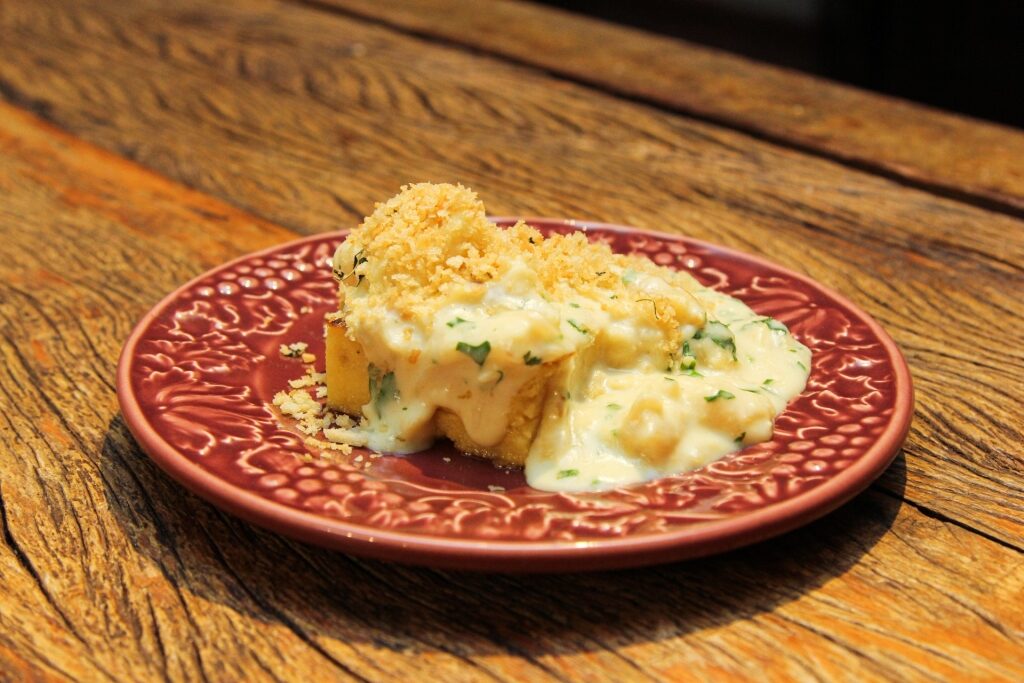
Baccalà mantecato
Baccalà Mantecato is another recipe that draws on the preservation techniques of the Venetian Middle Ages.
Baccalà is created by packing a cod in salt and drying it, after the manner of Norwegian stockfish. Cheap, nutritious, and long-lasting, it’s a staple that, when cooked well, delivers a firmly textured and satisfying meal.
Baccalà Mantecato is the apotheosis of baccalà. Translated as “whipped codfish”, the ordinarily stiff fish is rehydrated through soaking before it’s poached, mashed, and whipped to a creamy fluffiness. Think of it as a kind of uber-light fish pâté.
Instead of toast, Baccalà Mantecato is served with slices or rounds of toasted polenta on which you spread the heavenly concoction.
Bigoli in Salsa
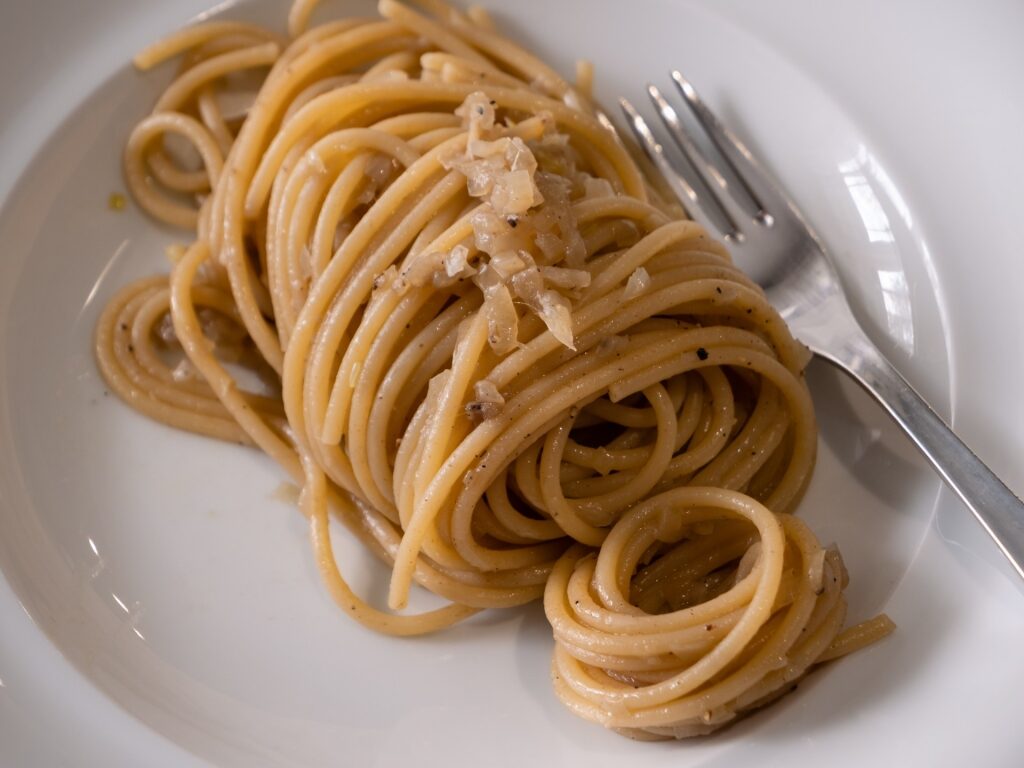
Bigoli in salsa
An ever-present Venetian “primi”, or first course, Bigoli in Salsa melds Venice’s seafood and pasta traditions into something truly memorable.
Anchovies are a key ingredient. Bigoli in Salsa is one of those dishes that shows off the tiny fish’s umami qualities to the full. For the dish, the anchovies are gently cooked until they liquify into a complex pungent sauce also that contains white wine and onions.
Enter the bigoli. These thick noodles are similar to the Tuscan pici, except for the narrow channel that threads the center. They’re originally made with buckwheat but you’ll usually find wholemeal bigoli on the menu today.
The earthy flavor of the bigoli stands up to the deliciously punchy sauce and makes for a dynamite first course, or even a main. Sprinkle parsley to finish.
Polenta e Schie
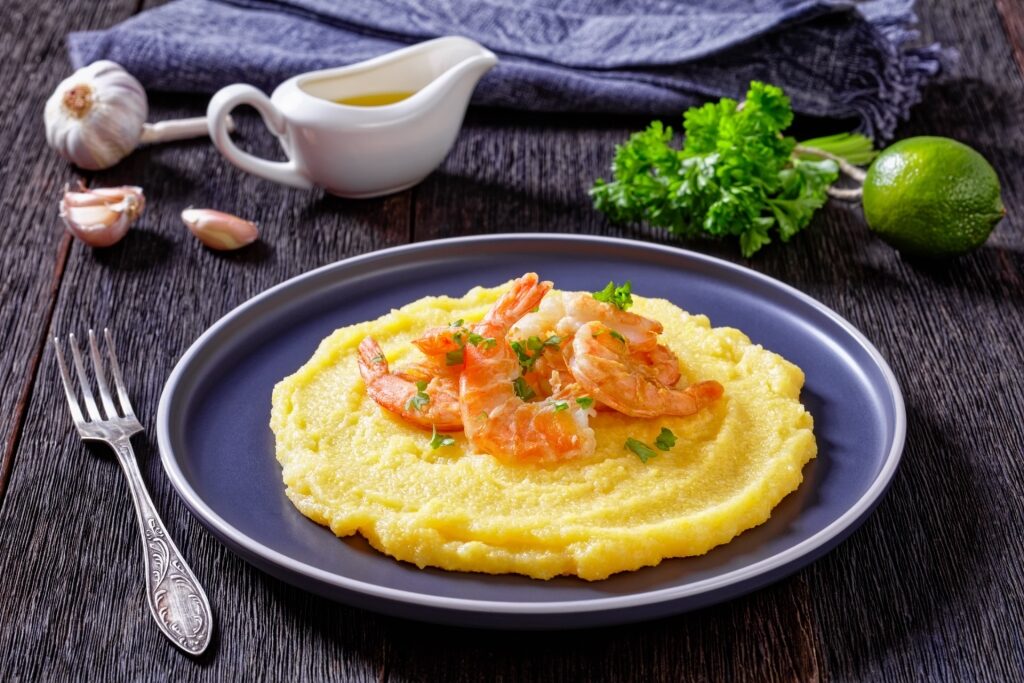
Polenta e schie
Polenta e schie is a fine example of how something that sounds poetic in Italian loses all music when translated into English: polenta and shrimps.
For the working class of Venice, this was a cheap and simple meal to put together after a day’s toil. The dainty shrimp of the lagoon would be caught, boiled or fried, and laid over a filling bed of polenta.
Today in La Serenissima, this Italian dish has become a favorite and refined starter. The shrimp are usually cooked in a garlic and white wine sauce, adding complexity—and a dash of poetry—to this former poor man’s meal.
Fegato alla Veneziana
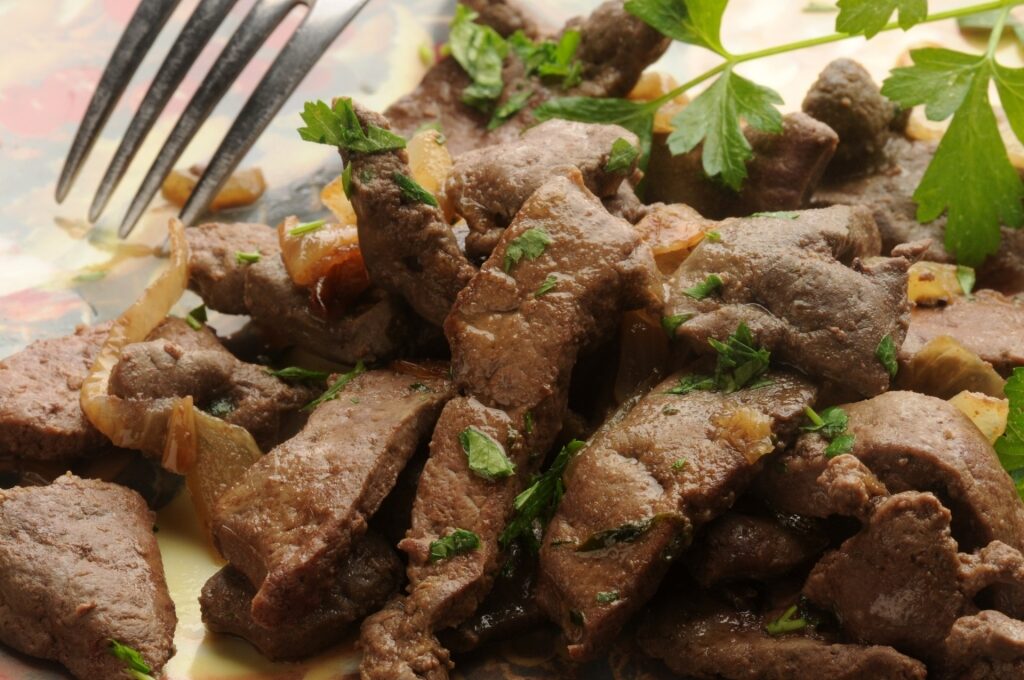
Fegato alla Veneziana
Translated as “liver Venetian-style”, fegato alla Veneziana is a dish held very close to Venetian hearts. For lovers of liver and onions, prepare to have your tastebuds exploded by this ultimate expression of that classic pairing.
The key to this dish is how thinly the calves’ liver is sliced. This allows the meat to be swiftly sauteed in a pan at a high heat, ensuring that the juices don’t have time to drain away. Some lemon and parsley are added before it’s served with fried polenta.
This dish dates back to the Roman era when figs were used instead of onions to balance out the liver’s bitterness. If you want to track down what’s regarded as the truly traditional version, travel to southern Choggia, across the Venetian lagoon, for a plate of figà a la Venesiana. This is the equivalent in the local dialect of the Italian “fegato alla Veneziana”.
Tiramisu
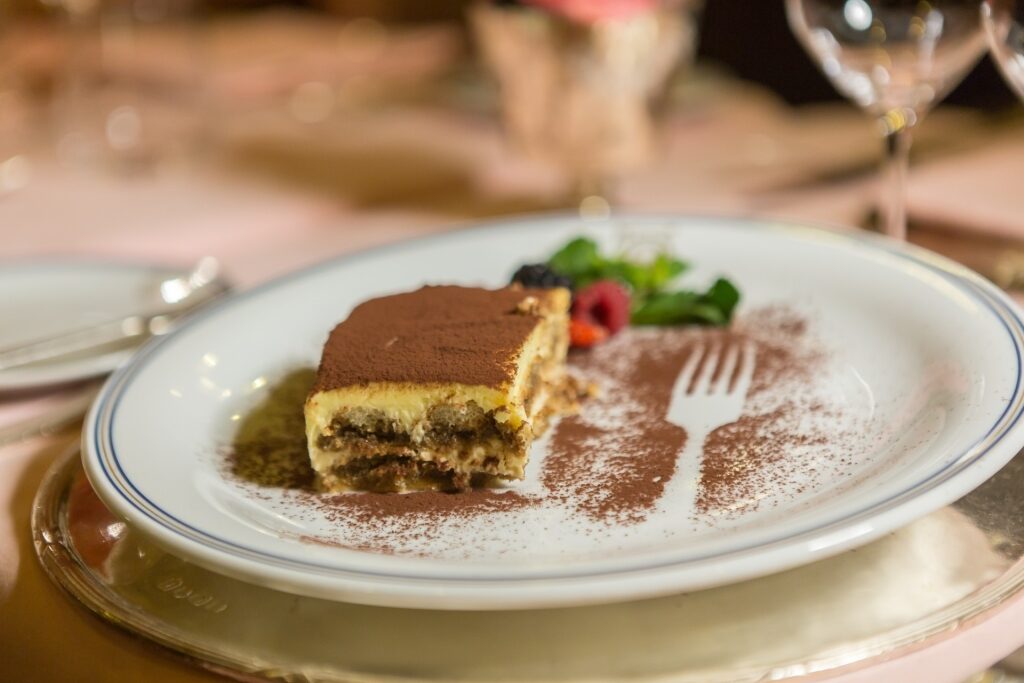
Tiramisu
Tiramisu is the first name on the team sheet when it comes to the Italian dessert trolley. It’s omnipresent throughout the peninsula, a sumptuous combination of sponge fingers, chocolate, and coffee that hits all the right notes with the Italian palate.
Its name translates as “pick me up”, which is a perfect description for a dessert that merges the Italian predilection for a meal-concluding espresso with something sweet. You’ll find fancy chefs attempting to reinvent tiramisu, but whatever delights they conjure will never supplant the original.
Was tiramisu inspired by La Serenissima, with the dessert’s soft edges, pleasing aesthetics, and striking vivacity? The dish certainly falls somewhere between solid and liquid, which, some might claim after a bottle of prosecco, clinches the matter.
Moeche
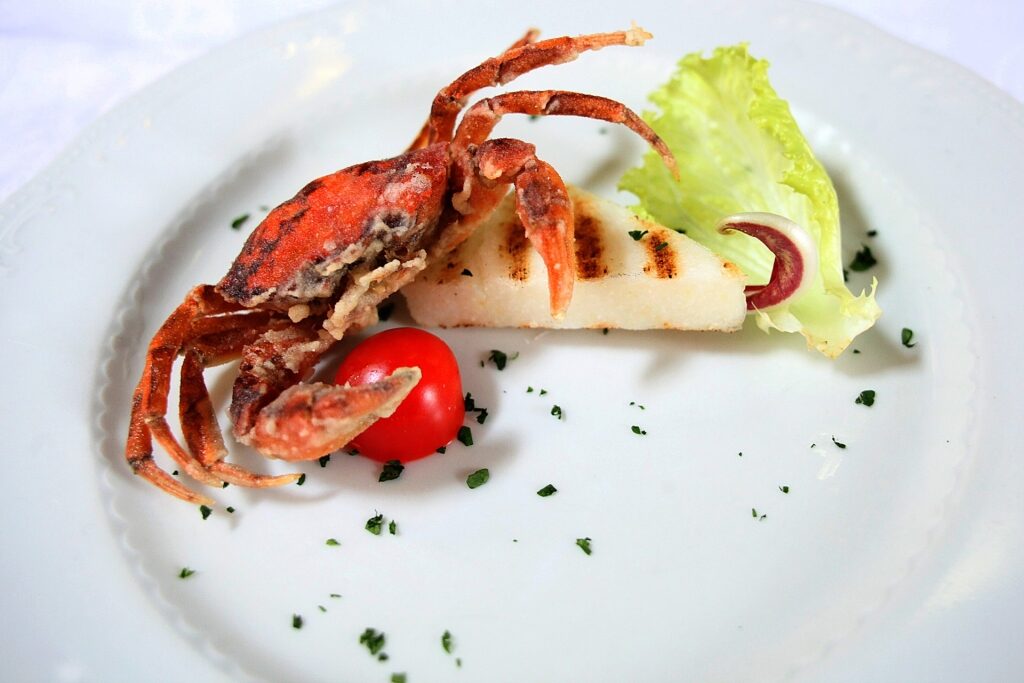
Moeche
A superstar of the Venetian fisherman’s haul is the moeche, diminutive green crabs that make for a twice-annual food in Venice delicacy.
The reason for the scarcity of times to enjoy soft shell moeche relate to the crab’s molting phase. This occurs only twice a year—in early spring and late autumn—and only for a few hours each time. During this window, they’re unprotected by a shell and are eagerly gathered by the local fisherman.
This catching of the crabs without their clothes on is a tradition that’s lasted for hundreds of years. Preparation of the moeche is straightforward. The Venetians flour the crabs, fry them, squeeze on some lemon, and take a deliciously crunchy bite.
Frittelle
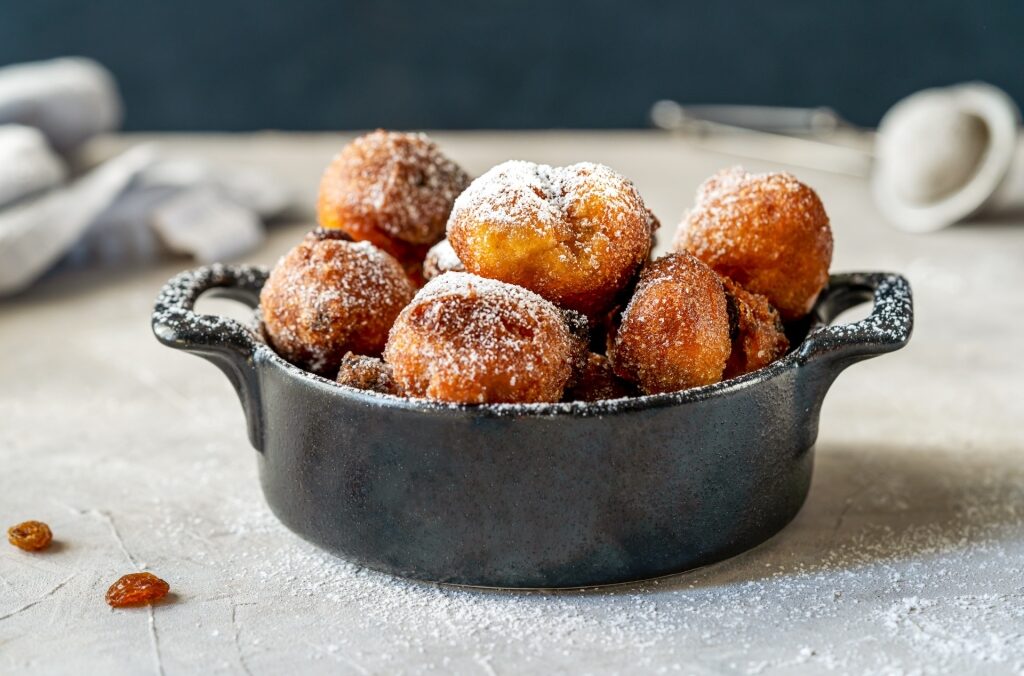
Frittelle
The frittella is the Venetian’s answer to a donut. But whereas a donut is for any time of the year, a frittella is usually only on offer during Venetian Carnevale.
The Carnevale is the moment that Venice is at its most thrilling and mysterious. Believed to have begun as a celebration to mark the end of winter, Carnevale today is a riot of costume and color.
Most distinctive are the masks, thought to elevate the sense of mystery and break down class barriers during this festive period.
The citizenry’s hankering for frittelle also surmounts class and breeding. Irresistibly crispy and slightly chewy dough conceals a heavenly core of zabaglione or some other creamy treat. The more traditional version of the frittella is laced with pine nuts and raisins. With the right mask, no one will be able to guess how many frittelle you’re consuming.
Buranelli
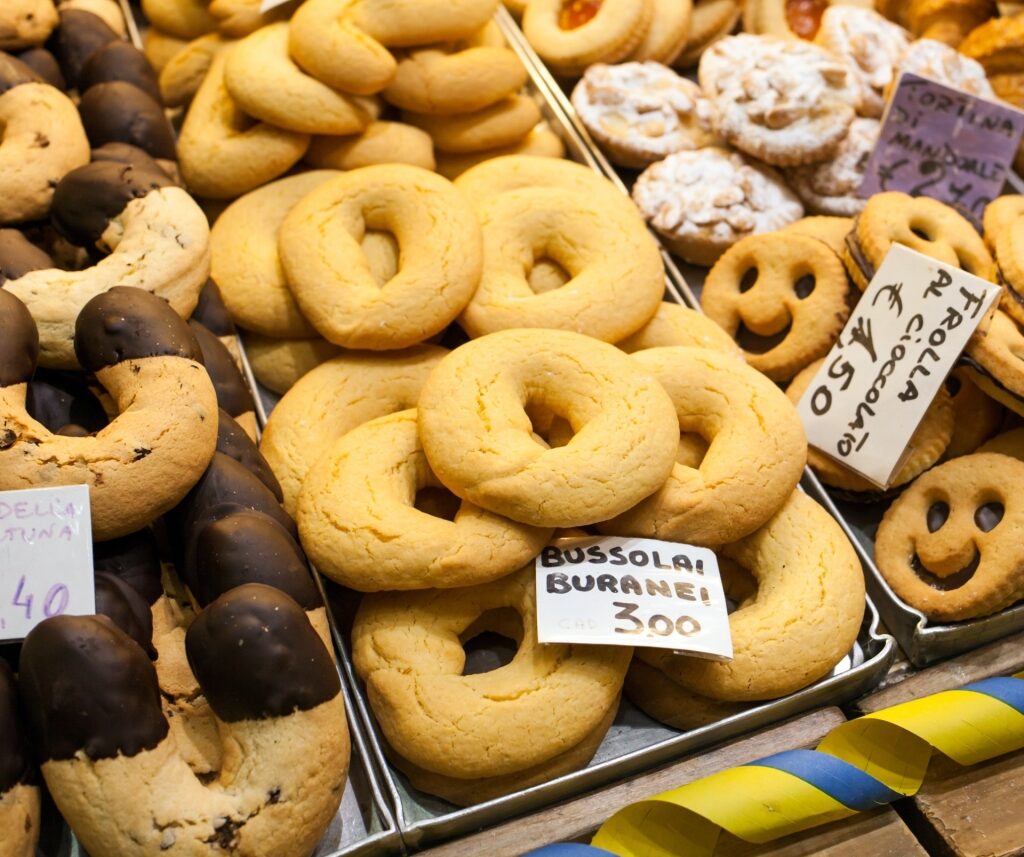
Buranelli
Another sweet favorite tied to a significant event in the Venetian calendar, buranelli are little round butter cookies traditionally eaten at Easter.
The buranelli are named for Burano, a clump of islets near the northern end of the lagoon. You can also find the biscuits called “busa” which, in the local dialect, refers to the hole in the center.
If you visit Burano, you’ll likely see buranelli on display in the windows of the island’s forni, or bakeries. Flavored with vanilla, rum, and zest, some are shaped like an “s” to make them easier to navigate into the narrow mouth of a glass of sweet wine.
Read: A Guide to Italian Wine & Food Pairings
Gelato

Gelato
From the strawberry and cream of the Doge’s palace to the peach, lemon, and hazelnut colors of the canalside palazzi, everywhere you look in Venice reminds you of gelato.
On top of that, you’re essentially by the seaside, which means ice cream is a must. This famous treat, while it’s not strictly a Venetian food, has been popular with Venice’s upper crust since the 17th century.
Beneath the sweltering heat of August, it’s even more of a necessity than usual. Look out for Crema dei Dogi—a vanilla and citrus-flavored scoop dedicated to the city’s former rulers.
Spritz Veneziano
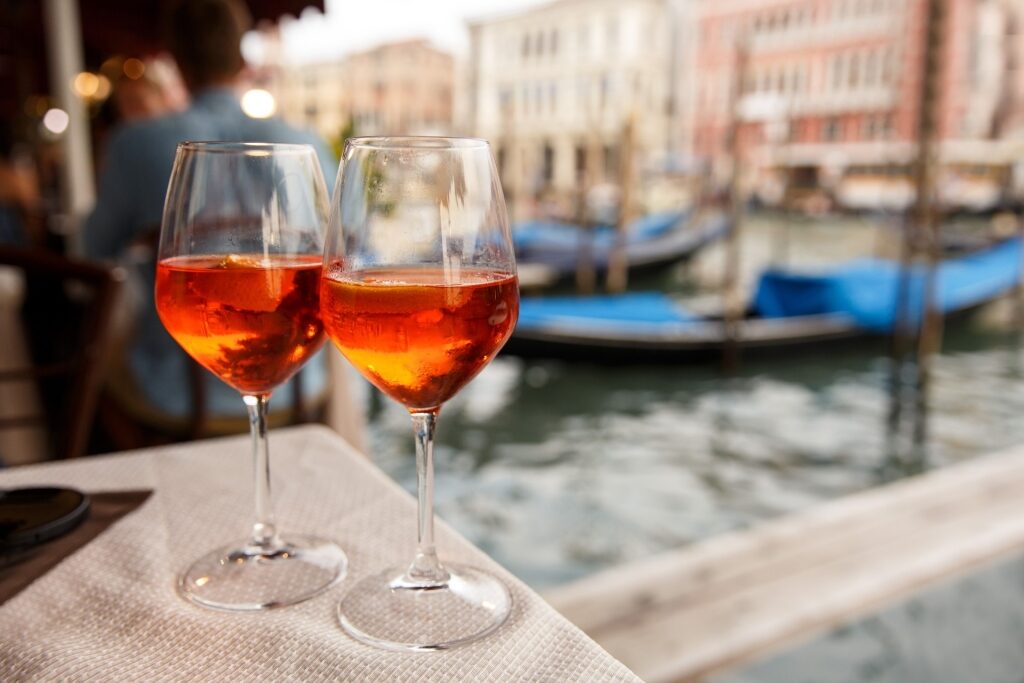
Spritz Veneziano
While the spritz is an omnipresent aperitivo enjoyed from the northern Dolomites to the seaside promenade of southerly Reggio Calabria, not all spritzes are the same.
As is often the case with things in Venice, the spritz is done a little differently, with perhaps a shimmer of added sophistication. This isn’t the Venetians trying to prove themselves superior to the rest of Italy. Instead, it’s an effort to retain the original spritz style, invented in the Veneto region in the 19th century.
The first thing any spritz lover will notice is that the Venetian Spritz is served in a tumbler. In place of a typical orange slice garnish, there’s a green olive, speared on a cocktail stick and balanced on the rim. The third and final difference is that Aperol is absent and a Venetian liqueur called Select is mixed in instead. It’s slightly more bitter and more boozy.
Sgroppino
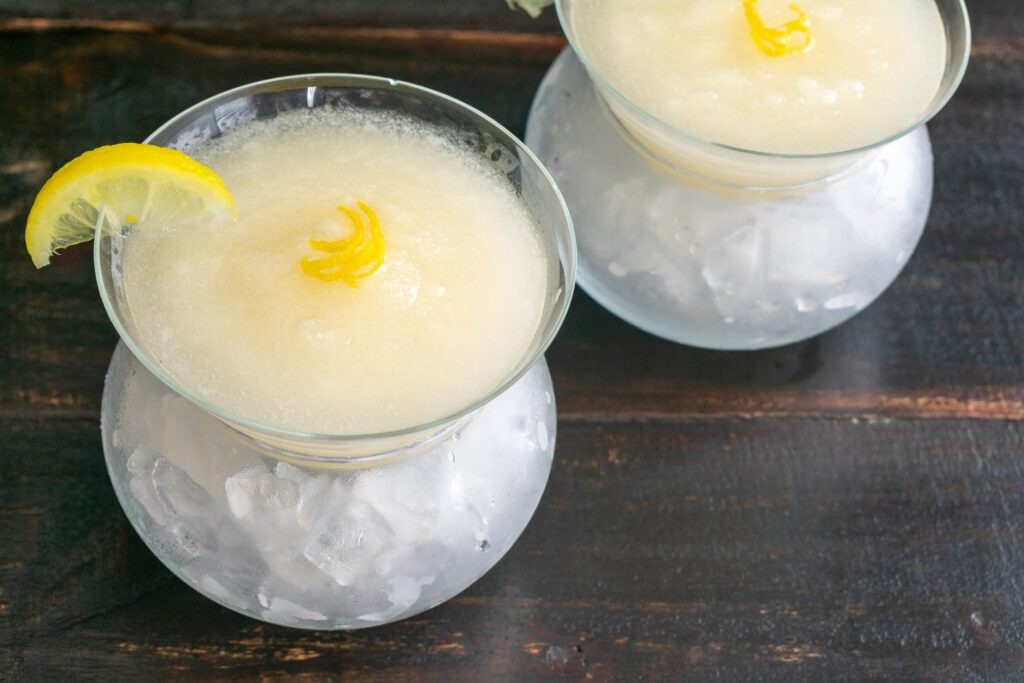
Sgroppino
The sgroppino is, for food in Venice, the taste of the summer. Usually served as a dessert, although available as a cocktail, the full sgroppino is a delicious blend somewhere between a slushie and a sorbet.
If you’re in the right kind of restaurant, ordering a sgroppino will induce the waiter to approach your canalside table with a serving trolley. You’ll then witness the production of this fabulous Venetian treat. One part lemon ice cream, another part pureed strawberries, it’s served in goblets and topped up with sparkling prosecco.
In some recipes, limoncello or vodka is added. Sip this delicious slushie and toast your good fortune.
Read: One Day in Venice
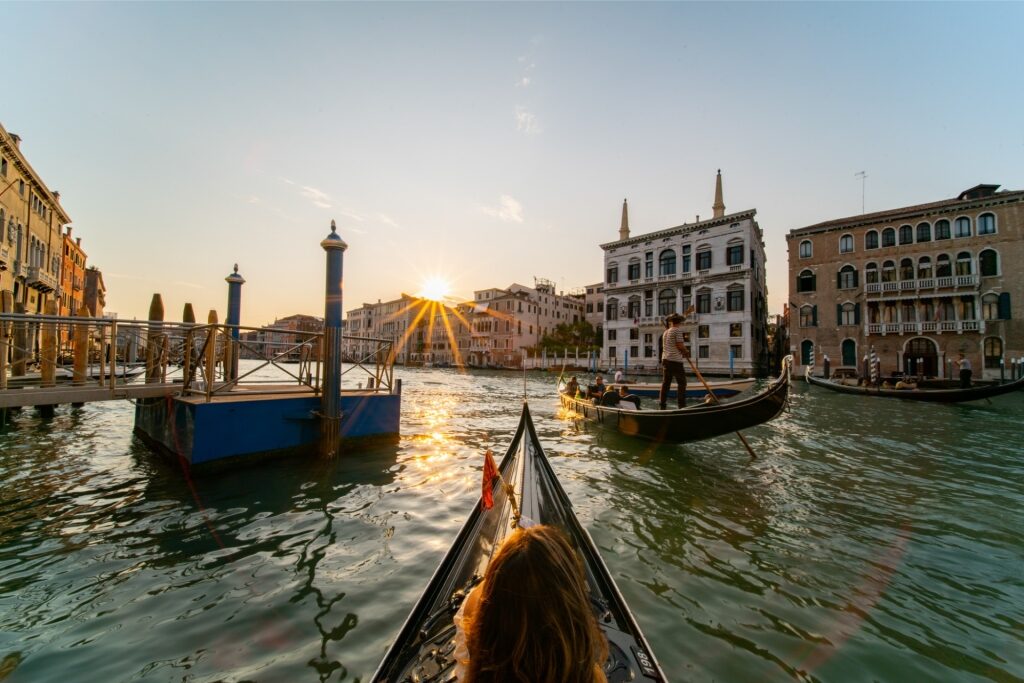
Venice
Discover the delicious food in Venice—along with the city’s romantic canals, stunning San Marco piazza, and towering artistic heritage on one of Celebrity’s cruises to Venice.
